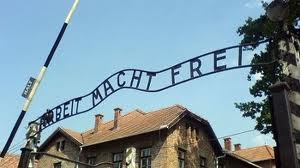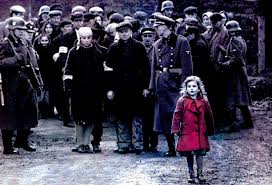PINK not BLUE
Cyanide gas produces two different colours, both vitally important for the debate over the German labour-camps. In the human body, it produces a red-pink colour as it kills - whereas, as it soaks into brick walls, it will very slowly produce a blue hue. These got rather confused in wartime testimony. Zyklon-B was the commercial name for the cyanide held in granular form, as it was delivered to the labour-camps. A whole lot of testimonies of blue dead bodies were given after the war – caused by gassing – and we here argue that these are simply impossible. BLUE
TESTIMONIES
The insecticide Zyklon was known as Zyklon-B and often called Zyklon-Blau because of the way it turned the walls blue.1 False witnesses kept testifying that blue-hue corpses were seen, imagining that the Zyklon somehow produced that.2 The so-called ‘Aktion Reinhardt’ camps, in the East of Poland - Treblinka, Belzec and Sobibor - have stories of carbon monoxide gassing, with up to two million allegedly dead. These stories have no reference anywhere to pink corpses being seen at these camps. Fake testimonies with impossible blue colour: Dario Gabbai, "some of them were black and blue from the gas" (1:55 mins into this Shoah Foundation video) Gabbai also states this in Laurence Rees' 2005 BBC program on Auschwitz, in episode 4, at 5:30. Ya’akov Silberberg: Q: When you took out the bodies, were they warm or cold? A: Warm. They were blue, black, and swollen. What I saw in the gas chamber was ghastly, a horrible scene... Q: What color were the bodies after the gassings? A: After the gassings they had a totally natural color, but after the blisters burst they turned red as fire. Interview by Joseph Sacker in Gideon Grief's book "We Wept Without Tears," Milton Buki: Of those gassed in a bunker: "the bodies were all naked and some had blue stains on them." - Mattogno, The Bunkers of Auschwitz, p. 116, declaration released on December 15, 1989, in Jerusalem. Natalia Zarembina: "the greenish tinge on the dead bodies does not disappear: it seems rather to become more distinct now in the new light of day. One of the grave-diggers, holding a corpse in his arms to throw it back on the cart, gazes into the greenish-grey face for a while. Years ago he saw similar faces: a deserted trench with corpses of soldiers. The same ghostly pallor. It is the discolouration of poison gas." Quoted, Mattogno, Auschwitz: the first gassing, pp. 34-36,1943 Polish pamphlet. Witnesses describing alleged gassed corpses agreed on the bodies being “greenish” (Kula), “bluish” (Banach), “green” (Hałgas), “blue” (Wolny), “bluish” (Kurant), “blue, almost purple-black” (Kielar), “bluish” (Weber), “bluish” (Gemański), “blue-black” (Petzold), “bluish” (Broad), whereas Natalia Zarembina speaks of a “ghostly pallor.” Mattogno Ibid., section 6.5. Walter Petzold: "The nature of the corpses, on account of the terrible effect of the poison gas, was such that one could see only blue-black, bloated, and mushy flesh that had once belonged to human beings. Cyklon ‘B’ has the property of disintegrating a human body almost completely, of causing the human lung to burst and of turning the rest of the body into a jelly-like state" – quoted by Mattogno. Stangl allegedly saw at Treblinka, ‘the pits full of black-blue corpses' - Wiki, Treblinka 'Their faces were blue, almost purplish' – at Auschwitz, a recollection of mass gassing of Russian Prisoners of War in September 1941. Chil Raichman, The Last Jew of Treblinka, Pegasus Books LLC, 2011, p. 65ff., p. 67. Yankel (Jankiel, Yankiel) Wiernik “There was no longer any beauty or ugliness, for they all were yellow from the gas. Kurt Gerstein:“The bodies were tossed out, blue, wet with sweat and urine, the legs smeared with excrement and menstrual blood. ” one of his reports, PS-1553, p. 7. Filip Müller: “Many had their mouths wide open, on their lips traces of whitish dried-up spittle. Many had turned blue, and many faces were disfigured almost beyond recognition from blows” - Eyewitness Auschwitz: Three Years in the Gas Chambers, 1979, published by Ivan R Dee, Inc , 1999, p. 117 Daniel Bennahmias: “When the door finally was opened, the Sonderkommando was assaulted by an overhelming stench and the ghastly sight of putrid flesh. The bodies had turned blue and were bloated to double and treble their normal size, and Danny was among those who had to extricate them.” Rebecca Camhi Fromer, The Holocaust Odyssey of Daniel Bennahmias, Sonderkommando. The University of Alabama Press, Tuscaloosa, 1993, p. 53. Polish officer who was sent to Treblinka with his Jewish wife on September 6, 1942, but escaped, in a report sent to the Polish government-in-exile in London on March 31, 1943: "I do not know what kind of gas is used, but I know from a colleague who worked three weeks in ‘Treblinka II’ that the corpses have a bluish color." Mattogno/Graf Treblinka BLUE Two colours have a central relevance to use of cyanide gas in WW2. Firstly, there is the blue/turquoise colour which glows on the walls of the old delousing chambers, due to ferrocyanide, as in a tube of paint, ‘Prussian blue’. Iron in the wall bonded with the cyanide as it was absorbed into the walls seventy years ago. The Leuchter and Rudolf reports changed forever the whole Revisionist debate, by showing that the blue walls of the little delousing chambers in the German labour-camps, written out of History at Nuremberg, were the one places where cyanide was used on a regular basis. Those old walls are blue inside and out, showing how the cyanide gas penetrated right through them. 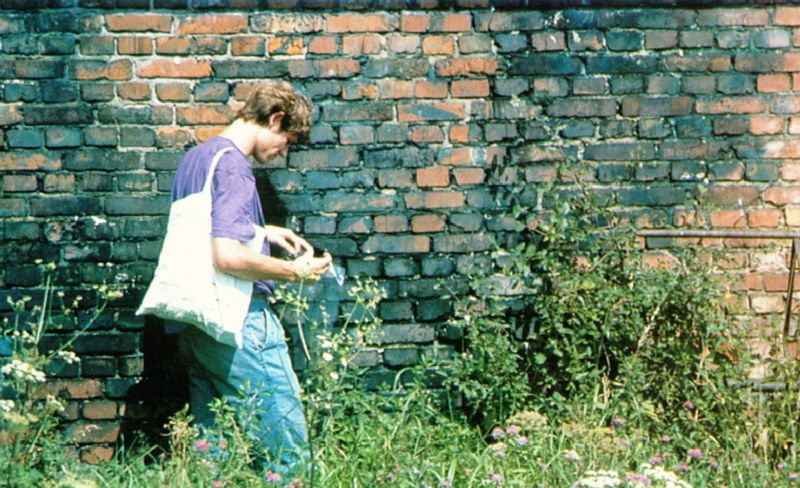 Seven tons of cyanide were delivered to Auschwitz just in the year 1942. That’s a lot. It was averred at Nuremberg that it was used for human gassing. Fortunately, Science can now resolve this big question for us. Both Leuchter and Rudolf chipped away dozens of wall-samples from the old buildings, then measured the cyanide; and their results showed five thousand parts per million of total cyanide on average in the little old delousing-chamber walls, the ones that are generally a deep blue colour; and only one to three parts per million in what are alleged in the big textbooks to be where the mass human gassing took place: buildings which do not have any trace of blue in the walls. They found similar ‘normal’ levels in wall samples from the old kitchens and bathrooms – suggesting they were fumigated maybe once or twice a year with cyanide, as a hygiene precaution. That’s a fairly open and shut case. Science results don’t come much better than that: a two-thousandfold differential, telling us where the cyanide was used - and where it wasn’t; indicating that the cyanide was used for a hygienic and not homicidal purpose.  PINK Then, there is the pink. A body killed by inhaling hydrogen cyanide dies through oxygen-denial, as cyanide blocks the body’s oxygen-metabolism. It cannot pass from blood into the body tissues, and in the death-struggle the body will end up bright pink. But, no-one ever heard of a bright pink pile of bodies in a German labour-camp, that’s for sure. Two gases were used to murder millions of Jews, so the official story has been telling us: cyanide and carbon monoxide. Hundreds of books have alleged this. 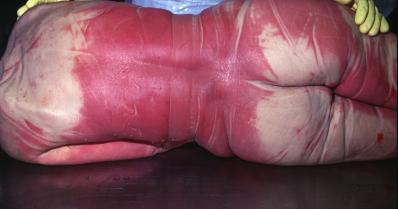 Carbon
monoxide was supposed to be present in Diesel
exhaust – except
that
it isn’t,
but that’s another story.
Holocaust orthodoxy claims One
third of the Holocaust was caused
by gassing with carbon monoxide, using Diesel
exhaust fumes, the other two-thirds being gassed
by cyanide. The latter was supposed to happen in
big, long rooms with holes in the ceiling, the
former more in travelling, mobile vans. There are
(of course) no photos available of these alleged
mobile death-vans. Carbon
monoxide was supposed to be present in Diesel
exhaust – except
that
it isn’t,
but that’s another story.
Holocaust orthodoxy claims One
third of the Holocaust was caused
by gassing with carbon monoxide, using Diesel
exhaust fumes, the other two-thirds being gassed
by cyanide. The latter was supposed to happen in
big, long rooms with holes in the ceiling, the
former more in travelling, mobile vans. There are
(of course) no photos available of these alleged
mobile death-vans. It happens that death by carbon monoxide also leaves a bright pink body. Like cyanide gas it kills by denying oxygen to the body - but does so differently, by forming carboxyhaemoglobin in the blood. 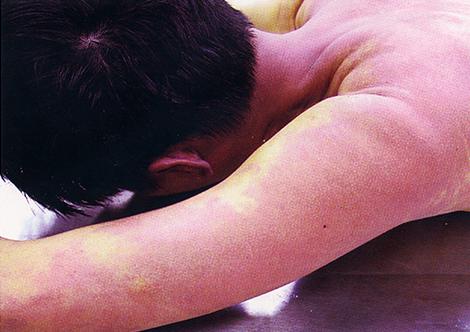 After that, the blood cannot any longer carry
oxygen. So the two main
gases allegedly used by the Germans to mass murder
Jews both leave bright pink bodies. No one realised this around the
time of Nuremberg, or indeed for several decades
afterwards. It is a relatively recent argument.
How could that be? No one
will ever show you a pile of bodies allegedly
gassed. No such remains were ever detected in any
German labour-camp. But, you will be shown piles
of very emaciated bodies which have clearly died
from two causes: starvation, plus typhus. Those
two were the killers. Sometimes if a body is
anaemic this pink hue may not appear. But, that
was not notably the case for labour-camp inmates.
One would have expected at least 90% of deaths to
show the pink hue, had CO or cyanide been a cause
of death.
After that, the blood cannot any longer carry
oxygen. So the two main
gases allegedly used by the Germans to mass murder
Jews both leave bright pink bodies. No one realised this around the
time of Nuremberg, or indeed for several decades
afterwards. It is a relatively recent argument.
How could that be? No one
will ever show you a pile of bodies allegedly
gassed. No such remains were ever detected in any
German labour-camp. But, you will be shown piles
of very emaciated bodies which have clearly died
from two causes: starvation, plus typhus. Those
two were the killers. Sometimes if a body is
anaemic this pink hue may not appear. But, that
was not notably the case for labour-camp inmates.
One would have expected at least 90% of deaths to
show the pink hue, had CO or cyanide been a cause
of death. MEDICAL REFERENCES 1. In all of the fatalities from acute carbon monoxide poisoning in which the victim was found dead at the scene, a conspicuous finding was the characteristic pink or cherry red post-mortem lividity of carboxyhemoglobin in the skin of the dependent portions of the body. These are readily distinguishable, because of their color, from ordinary post-mortem lividity.’ - American Journal of Public Health, March 1952, p.262 (Source: F. Berg) 2. Carbon monoxide poisoning may be diagnosed easily, because its inhalation in lethal quantities produces a characteristic cherry red coloration in the areas of hypostasis. A similar reddish hue is seen in cases of cyanide poisoning. - D.A.L. Bowen "Medical Investigations in Cases of Sudden Death," British Medical Journal, 1 April 1967, page 35 3. Picture (above) from Textbook of Maritime Medicine . "Fig. 10.9.2: Bright red lividity on the dorsal side of the body as the expression of lethal carbon monoxide poisoning. Livor mortis is bright red in cases of carbon monoxide or hydrocyanide poisoning (or in cases where the corpse is kept in cold storage). 4. When carbon monoxide binds with haemoglobin in the blood or myoglobin in the muscles it forms carboxyhaemoglobin and carboxymyoglobin respectively and they are responsible for the pink coloration. There are cases in which carbon monoxide poisoning does not result in the formation of a cherry pink coloration (Carson & Esslinger, 2001) and it can be difficult to spot when the victim is dark skinned – though it may be apparent in the lighter regions such as the palms of the hands or inside the lips or the tongue. - Alan Gunn, Essential Forensic Biology, 2009 pp. 21-22 5. Autopsy findings in CO deaths are fairly characteristic. In Caucasians, the first impression one gets on viewing the body is that the person looks very healthy. The pink complexion is caused by coloration of the tissue by carboxyhemoglobin, which has a characteristic cherry-red or bright-pink appearance that can be seen in the tissue. Cherry-red livor mortis suggests the diagnosis even before autopsying the individual - Vincent DeMaio, Dominick DeMaio. Forensic Pathology, 2nd ed. 2001 p. 395. 6. A pink lividity, rather than the usual purple-red, raises the possibility of death from carbon monoxide poisoning, cyanide or hypothermia - Encyclopedia of Forensic Sciences / edited by Jay Siegel, Geoffrey Knupfer, Pekka Saukko, 2000 p. 1158, article "Autopsy" 7. Cyanide overdose can be fatal six to eight minutes after ingestion. Rapidly causes weakness, confusion, coma, and pink skin from high blood oxygen saturation. Produces an almond-like odor. - Forensic Science: Fundamentals and Investigations / Anthony J. Bertino 2012 p. 258 CONCLUSION There were conditions of deep horror at the camps, as found when they were liberated by the Allies, but that horror was not designed by the Germans to be there. The lie at Nuremberg of mass human gassing was mainly a case of the Allies believing their own propaganda: the BBC started promulgating the gassing stories in 1942. The chemical evidence clearly shows that Zyklon was used from mid-1942 onwards exactly as the Germans said it was used viz for delousing clothes, in purpose-built delousing chambers; and that diesel exhaust is not lethal, because it does not contain sufficient carbon monoxide to kill people. A study of alleged carbon monoxide poisoning concluded, ‘witnesses such as Reder, “Szlamek” and Rosenberg would have observed a very large number of bodies showing cherry red discolouration. That not a single one of the alleged eye-witnesses to mass gassings at the above listed camps mention the highly eye-catching type of discolouration that most often accompany lethal carbon monoxide poisoning is in itself enough to throw doubt upon the alleged truthfulness of their statements’ |
